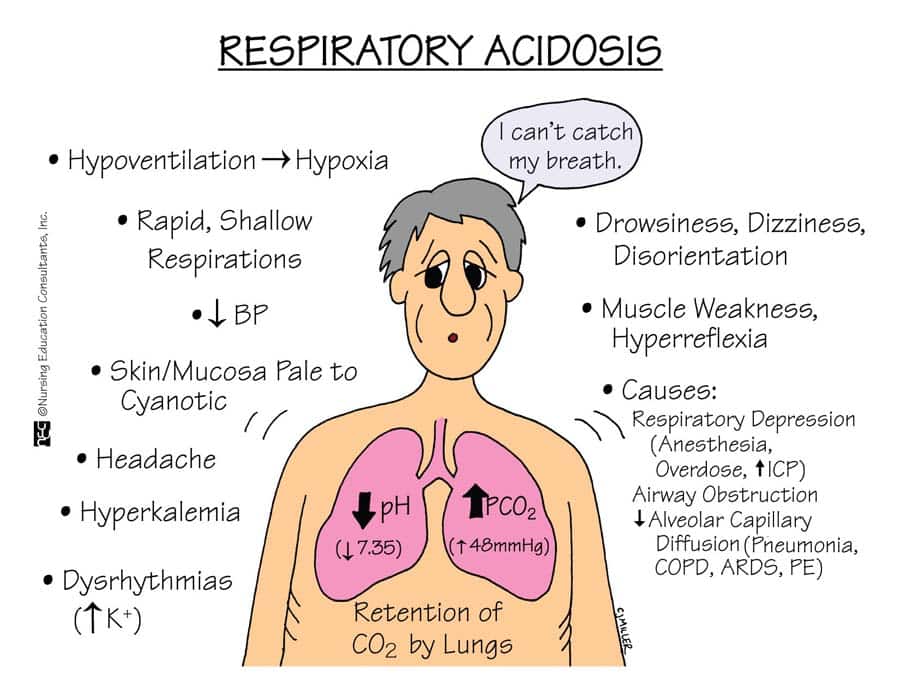Respiratory acidosis is associated with:
Increased neuromuscular excitability
Increased carbonic acid
Increased pH
Hypokalemia
The Correct Answer is B
Choice A Reason:
Increased neuromuscular excitability is not typically associated with respiratory acidosis. Instead, respiratory acidosis can lead to symptoms such as confusion, fatigue, and shortness of breath due to the buildup of carbon dioxide in the blood. Neuromuscular excitability is more commonly associated with conditions like hypocalcemia.
Choice B Reason:
This is the correct answer. Respiratory acidosis occurs when the lungs cannot remove enough carbon dioxide (CO2) from the body, leading to an accumulation of CO2 in the blood. This increase in CO2 results in the formation of carbonic acid, which lowers the pH of the blood. The elevated levels of carbonic acid are a hallmark of respiratory acidosis.
Choice C Reason:
Increased pH is not associated with respiratory acidosis. In fact, respiratory acidosis is characterized by a decrease in blood pH due to the accumulation of carbon dioxide and the subsequent increase in carbonic acid. Therefore, this choice is incorrect.
Choice D Reason:
Hypokalemia, or low potassium levels, is not typically associated with respiratory acidosis. Instead, respiratory acidosis can sometimes lead to hyperkalemia (high potassium levels) due to the shift of potassium out of cells in response to the acidotic state. Therefore, this choice is incorrect.

Nursing Test Bank
Naxlex Comprehensive Predictor Exams
Related Questions
Correct Answer is B
Explanation
Choice A Reason:
Disease treatment refers to the management and care of a patient to combat a disease or condition. This includes interventions aimed at curing the disease, alleviating symptoms, or preventing complications. While physical therapy can be part of disease treatment, in the context of a heart attack, it is more accurately described as a form of tertiary prevention.
Choice B Reason:
Tertiary prevention involves measures taken to reduce the impact of an ongoing illness or injury that has lasting effects. This includes rehabilitation and efforts to prevent further complications or deterioration. Physical therapy after a heart attack is a classic example of tertiary prevention, as it aims to improve the patient’s quality of life, enhance physical function, and prevent further cardiac events.
Choice C Reason:
Secondary prevention focuses on early detection and prompt intervention to prevent the progression of a disease. This includes screening tests and early treatment of conditions to halt or slow their progression. In the case of heart disease, secondary prevention might involve regular monitoring of blood pressure and cholesterol levels to detect and manage risk factors early.
Choice D Reason:
Primary prevention aims to prevent the onset of disease before it occurs by reducing risk factors and promoting healthy behaviors. This includes lifestyle changes such as a healthy diet, regular exercise, and smoking cessation to prevent the development of heart disease in the first place. Physical therapy after a heart attack does not fall under primary prevention, as it is an intervention after the disease has already occurred.
Correct Answer is A
Explanation
Choice A: Size
Muscular hypertrophy refers to the increase in the size of muscle cells12. This process typically occurs as a result of strength training, where the muscles are subjected to stress and damage, leading to the repair and growth of muscle fibers. The increase in muscle cell size enhances muscle strength and mass, making it a key goal for athletes and bodybuilders.
Choice B: Vacuoles
Vacuoles are membrane-bound organelles found in cells, primarily involved in storage and transport of substances3. While vacuoles play important roles in cellular function, they are not directly related to muscular hypertrophy. The primary change in muscular hypertrophy is the increase in muscle cell size, not the number or size of vacuoles.
Choice C: Types
Muscle cells can be categorized into different types, such as slow-twitch (Type I) and fast-twitch (Type II) fibers4. However, muscular hypertrophy does not involve a change in the types of muscle cells. Instead, it focuses on the growth and enlargement of existing muscle fibers, regardless of their type.
Choice D: Number
An increase in the number of muscle cells is referred to as hyperplasia, which is different from hypertrophy. Hyperplasia involves the formation of new muscle cells, whereas hypertrophy involves the enlargement of existing muscle cells. Current evidence suggests that hypertrophy, rather than hyperplasia, is the primary mechanism for muscle growth in response to strength training.

Whether you are a student looking to ace your exams or a practicing nurse seeking to enhance your expertise , our nursing education contents will empower you with the confidence and competence to make a difference in the lives of patients and become a respected leader in the healthcare field.
Visit Naxlex, invest in your future and unlock endless possibilities with our unparalleled nursing education contents today
Report Wrong Answer on the Current Question
Do you disagree with the answer? If yes, what is your expected answer? Explain.
Kindly be descriptive with the issue you are facing.
